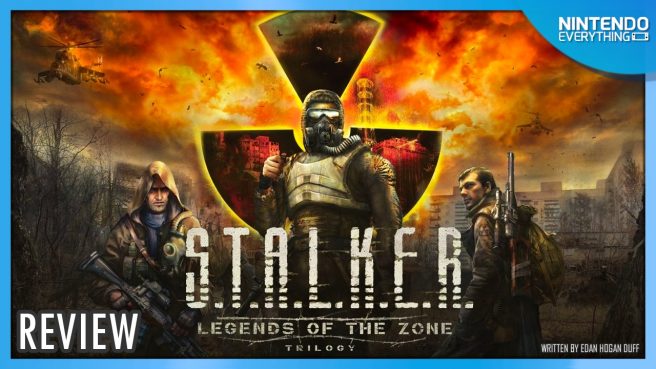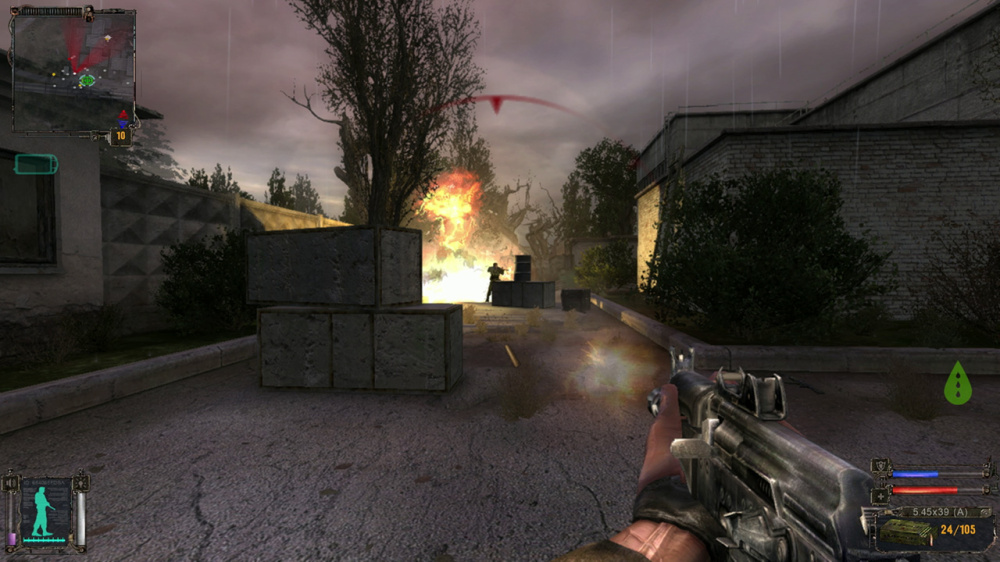S.T.A.L.K.E.R.: Legends of the Zone Trilogy Nintendo Switch review
System: Switch
Release date: October 31, 2024
Developer: GSC Game World / Mataboo
Publisher: GSC Game World
As a platform, the Switch has treated us to some serious wildcard franchise appearances over the last seven years. Few would have bet in 2017 that the hybrid console’s library would eventually be bolstered by almost every Saints Row, Sniper Elite, Metal Gear Solid, and Resident Evil game – to name but a few. However, here we are, being machine-gunned with ports and re-releases that continuously cement the Switch’s status as a Nintendo all-timer. As if our collective Switch-port bingo cards weren’t already full to the brim, GSC Gameworks have emerged forth, bringing the entire S.T.A.L.K.E.R trilogy lovingly nestled under their arm. Hang on – what?
For the uninitiated, the S.T.A.L.K.E.R series is one of the cultiest cult classic PC franchises in the broader gaming pantheon. Developed and published by Ukrainian outfit GSC Gameworks, it’s an unforgiving post-apocalyptic survival FPS set predominantly in a fictionalized version of the modern Chornobyl Exclusion Zone. As per the game’s lore, decades of decay have eroded the physical landscape and moral rationale of those who choose to reside in their penned-off nuclear playground, and your main goal is, primarily, survival. Across three entries released in just three years – 2007, 8, and 9 – GSC Gameworks established a world that feels unlike any other found in games. It’s janky, yet it’s earnest. It’s bleak, and yet it’s beautiful. Cast an initial eye across any S.T.A.L.K.E.R game and – much like swathes of late 00’s gamers – you’ll likely dismiss it as just another product of the post-apocalyptic glut. Do this at your peril, as these are some of the best games you can play on your Switch this year.
One of the first things that hits you once you boot up any of the games contained in this bundle is how fantastically out of step the experience feels in comparison to just about every other title cocooned within the post-apocalyptic survival horror genre. This is perhaps the main draw of the franchise, as it distinguishes itself by being uncompromisingly original in its execution. The first game in the series, Shadow of Chornobyl, casts you as an un-named amnesiac who is stranded without context within the harsh environs of “The Zone”. Across the span of the opening hours, you are quickly confronted with the brutally unforgiving nature of its setting. S.T.A.L.K.E.R is difficult by design, and ruthlessly so – its punishing nature is a tacit reflection of the history very much associated with the setting’s real world counterpart. I can’t quite stress how difficult these games are, and I feel compelled to labor the point – they are very bloody difficult. There’s an old-school PC flavor to the combat and exploration, akin to the Half Life games, or to Fallout 3. Being a product of the late 00’s, it’s understandable that GSC would look to their contemporaries for inspiration – however, the overall identity and flavor of S.T.A.L.K.E.R’s mechanics are entirely unique to the franchise – and are compellingly addictive as a result. Yes, you’ll die upwards of one hundred times throughout the span of each game, but you’ll be endlessly drawn to load your last quicksave and approach the situation from a new angle.
In terms of structure, each S.T.A.L.K.E.R game takes an open world map and then divides it into a series of interconnected levels. Each of these areas has a distinct visual flavor and enemy set, and although it’s certainly a more dated approach to open-world design, the segmented nature of the map allows for an easier time in remembering where everyone and everything is. As you explore, you’ll come across friendly NPCs that dish out quests and advice, as well as not so friendly NPCs that dish out bullets and game-overs. There’s a rudimentary dialogue tree system that doesn’t have the kind of depth seen in the likes of a Bethesda or Larian game, but it does involve you in the conversation enough that you feel as though you’re responsible for trading and talking your way through this mucky, shooty, nuclear cesspit. You can choose your allegiance and improve your standing with a variety of factions in each title by completing their tasks and building up a reputation for yourself. This system is iterated on over the course of the trilogy, and is noticeably fleshed out by the time you reach the third game. There’s a kind of soft-touch flavor to the way in which these alliances – and also the decisions you make – work in S.T.A.L.K.E.R. Other games will constantly remind you of the weight and significance that your actions have on the world around you, whereas in S.T.A.L.K.E.R, you’re very much just one person doing what they can to scrape together an understanding of the world around them. Your choices certainly have impact, but it can be messy and unclear what the outcomes are. This feels believable in a way that a lot of other games aren’t.
One of the more noticeable advantages to aligning yourself with any one of each game’s factions is access to better gear, which is your primary means of improving your survivability out in The Zone. Despite looking and smelling like a post-apocalyptic RPG, there are no traditionally permanent stat boosts or levelling mechanics in S.T.A.L.K.E.R. As you face progressively tougher enemies and missions, you’ll acquire guns and armor with various buffs and benefits over early game loot, such as radiation resistance, and protection against the eponymous “anomalies” that pepper the landscape. Those anomalies in particular are one of the key ways that the games subtly slow your progress early on. They are mostly invisible environmental instabilities, born directly from the nuclear disaster that crippled The Zone. Only for a PDA-attached beeper that alerts you to their presence, you’d have a very tough time avoiding them. Some will chuck you about like a discarded plastic bag, others will jet flame directly from the ground beneath you. The one upshot to these disturbances is that where there are anomalies, there are normally artifacts – these are naturally occurring nuclear treasures that boost your stats when you equip them – they also fetch a nifty price with the local traders. Most of these trinkets will come with a distinct drawback, such as improving your health at the cost of crippling your stamina. Some of the rarest ones you can find, however, have only good things to add to your arsenal.
As if warring military groups and environmental hazards weren’t enough to contend with, there’s also the obligatory variety of augmented nuclear beasties lurking around almost every corner. Packs of blind irradiated dogs, bloodsuckers that can render themselves invisible, zombies with guns – I’ll stop there, as it would be a shame to spoil some of the more unique horrors you’ll come up against throughout each game. I’m especially impressed with the lack of fanfare associated with their emergence, too – more often than not, they’ll just appear, a terrifying and unexpected new twist on the area you’ve chosen to skulk around in. That lack of pomp and circumstance is actually quite common throughout these games, and not just when it comes to its enemy types. There’s an earnest, laissez-faire tone that threads itself throughout many of the characters and scenarios you’ll come across in the series, and it’s hard not to attribute this to the fact that S.T.A.L.K.E.R is set in GSC Gamework’s figurative back-yard. Of course it’s fantastical and inherently “videogame-y”, but you feel as though this world is familiar and genuine, an immovable fact of life for the individuals that created it.
That down to earth sincerity thankfully goes a long way toward mitigating some of the series’ more abrasive elements. Out of the box, the Switch experience is not the fluid, hotkey-enabled treat that the original PC experience was almost twenty years ago – far from it. Aiming your weapon is laborious, movement feels unweildy, and navigating the achingly 2000’s-coded UI is less than intuitive. GSC Gameworks enlisted the help of porting studio Mataboo to rework the game for consoles, and while the effort is appreciated, it isn’t strictly a modern experience. With some trial and error, it becomes easier to deal with the ingame map and mission trackers – albeit with routine glances at the toolbar that furnishes the bottom of the screen. As for the controls, enabling gyro aiming when you look down sights and cranking up the aiming sensitivity results in an intensely rewarding combat loop. Headshots are absolutely essential, and lining them up with a subtle twist of the wrist is hugely satisfying. The inclusion of a quickselect wheel for cycling through your equipped weapons is welcome, however it’s utility is stunted by the fact that you still need to find a safe space and hop into your inventory if you need to cycle out your primary or secondary firearm for a different one. During an intense firefight, this is about as doable as playing GameCube games on your Switch – theoretical at best.
You’ll notice that up until this point I’ve been reticent to explore the story of each game bundled in the Legends of the Zone Trilogy – and, well I am. The nicest thing I can say about the narrative chops on display within S.T.A.L.K.E.R is that they’re fine. There’s a decent amount of mystery and intrigue that will certainly keep you amply motivated as you barrel your way through each main quest – it’s the localization that falls shockingly short of the mark. Often times, you’ll have conversations with key characters that are nigh-on incoherent – especially when there’s humor involved. A lot of the subtext and implicit meaning behind the dialogue has been totally lost in translation. Forget weapon wheels – some touch-ups to the dialogue and writing would have been preferable in this instance. If gripping and taut exposition is high on your list of inclinations, you’ll be better served elsewhere. While we’re on the topic of downsides, the trilogy’s technical performance is also lacking where it counts. I’m quite partial to the heavily normal-mapped, chunky look of the game’s art – and the game’s environments never fail to impress in that regard – but the frame rate is very poor at times, and that’s whether you’re playing docked or in handheld mode.
The Verdict

To be frank, none of that really negates the appeal of the S.T.A.L.K.E.R series on Switch. The one word I keep coming back to internally as I write this review is earnest – the games just feel so earnest. If there’s one thing you definitely won’t find in S.T.A.L.K.E.R, it’s the all-things-for-all-people design philosophy blunting modern games down to stumps. As you scrape through each combat encounter, shovelling down medkits like a competitive eater, or as you’re out there dodging anomalies and bartering with shady barmen, it never feels phoned, lazy, or lacking in intent. The S.T.A.L.K.E.R titles feel as though they were only ever meant to exist as they are, produced by a team that knew exactly the kind of games that they wanted to make. Not only that, but they got to make them in their own image – which is a rare occurrence these days. Being intimately familiar with the setting and inspiration, GSC Gameworks made something incredibly unique and fascinating – and I thoroughly recommend that you play it.
S.T.A.L.K.E.R.: Legends of the Zone Trilogy copy provided by the publisher for the purpose of this review.



